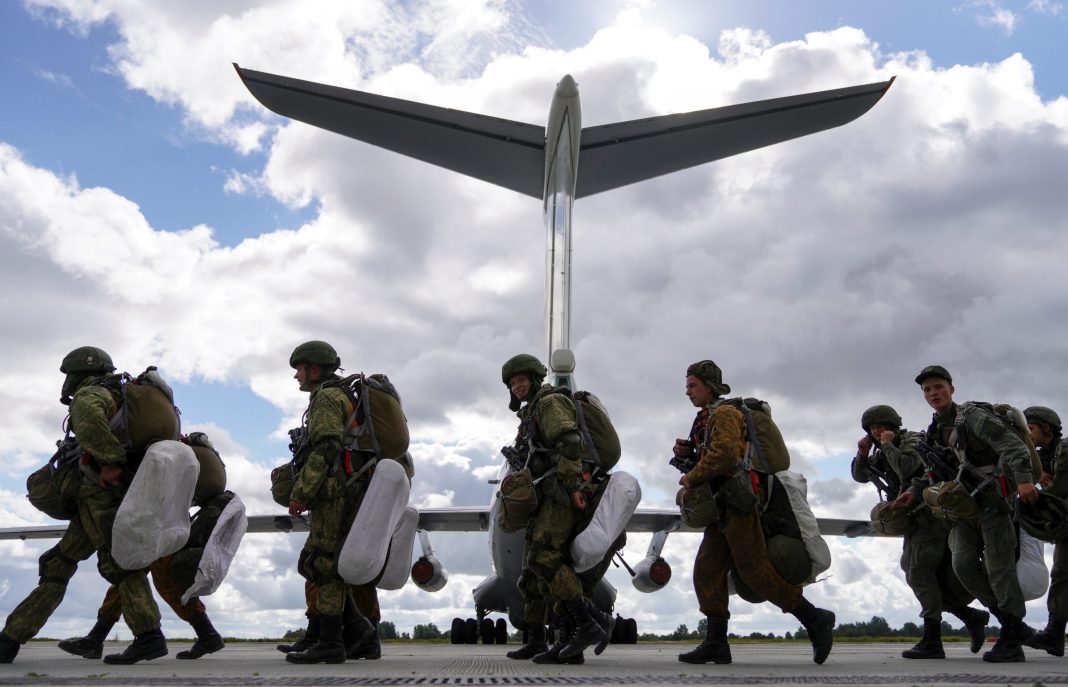By Valentin Châtelet, Sayyara Mammadova, for DFRLab
Russian media and Telegram channels are spreading unsupported claims to incriminate the Baltic states for a large-scale drone attack against Russia. On the night of August 29, several Russian regions were struck in a drone attack. Russian media claimed that most of the drones in Bryansk, Moscow, Ryazan, Kaluga, and Orlov were intercepted, though it appears that the attack destroyed four Russian Il-76 transport aircrafts at Pskov International Airport and struck a nearby oil depot.
The airport is reportedly used as a storage base for military airplanes. On August 30, Russian state media outlet TASS reported that it was closed to civilian flights. Satellite imagery posted that same day by the RFE/RL-affiliated Ukrainian investigative outlet Skhemi showed two of the four allegedly destroyed IL-76 transport aircrafts.
On social media, the attack stirred up accusations against the Baltic states, with some arguing that drones launched from Ukrainian territory could not reach the airport, located nearly five hundred kilometers northwest of Moscow. Unsupported claims surfaced online accusing Estonia and Latvia of being behind the attack. Russian propagandist Vladimir Solovyov commented on the reported attack on live television, calling for Russia to “destroy the Baltic countries, wipe them off the surface of the Earth.”
Various narratives emerged in Russian news outlets pointing fingers at Latvia and Estonia. For example, the pro-Russia media outlet Tsargrad cited military correspondent Yuri Kotenok to report that the drones may have come from outside Ukraine. On Telegram, the outlet claimed, “Some sources suggest the drones could have been launched from the Latvian side.”
A more specific theory emerged on Telegram accusing Latvia’s 31 and 32 battalions and the Estonian Defense League of conducting the drone attack. This theory circulated on the Russian propagandist channel Antifascists of the Baltics. “Tonight, NATO member countries – Latvia, Finland, Estonia – attacked the location of the 76th Airborne Division of the Russian Federation in the city of Pskov,” the channel claimed in an initial post on the attack, which received more than 350,000 views. “The anti-fascists of the Baltic States received numerous reports from local residents indicating that the drones attacking the military airfield in Pskov were launched from territory across the Baltic frontier.” A follow-up post, which received over 320,000 views, alleged that residents along the borders of Latvia and Estonia heard the sounds of helicopters and planes engaged in agricultural-related aviation. “We assume that what the locals took for the work of light aircraft engines could be the work of drone engines,” the channel hypothesized.
Subsequent posts on the Telegram channel contained screencaps from Yandex Maps showing distances from the alleged launch locations in Estonia and Latvia. These too garnered more than 300,000 views apiece.

The screencap of the Latvia map was then forwarded by the Telegram channel of pro-Russian Ukrainian blogger Mikhail Onufrenko, where it received an additional 286,000 views. His copy of the screencap then appeared in the Russian media outlet VKPress. Onufrenko also reiterated the claim in an interview with Russian press agency Regnum. “Most likely, Estonia and Latvia were included in this operation due to their proximity to the [Russian] border,” he said.
Pro-Kremlin media cited Russian influencers to add credence to the rumor. The DFRLab observed multiple outlets quoting the Telegram channel of TV presenter Ruslan Ostashko to allege that the drones could have been launched from the Baltic states. Russian news website Pravda.ru and local media outlet Yakutians cited Ostashko as a source, as did Monavista and 9111.ru. URA News cited Russian military expert Boris Dzherelyevsky to allege that Ukrainian forces could not have launched the drones from their territory. “If the launch took place in Pskov, then it could have been carried out from Estonia,” he said, adding, “There are at least two bases of the British Special Airborne Service in the areas bordering Russia.” This narrative was then echoed in the Russian online newspaper Moskovsky Kosmolets, which reported that drones launched from the Baltic states would “be regarded as a formal reason for declaring war.” Meanwhile, in a conference call with Russian media, Kremlin spokesperson Dimitri Peskov would not confirm an official position regarding the origin of the drones, stating that making an assessment was “the prerogative of our military experts.”
Blaming unspecified “Turkish media”
In numerous cases, Russian media vaguely cited “Turkish media” when reporting on the purported launch of drones from the Baltics, including Argumenty I Fakty, Radio1, Yakutians, Pradva.ru, 100.news, and the Strategic Culture Foundation. Only one media outlet, Amic.ru, attempted to cite a source, pointing to a post on the pro-Russian Telegram channel Militarist. This, in turn, proved to be a dead end as well, stating without evidence or sourcing, “The Turks write that the UAVs in Pskov were launched from Estonia.” It is possible that Militarist was the first Russian entity to credit Turkish media, as it preceded similar Russian media coverage.
The DFRLab analyzed Turkish mainstream media coverage of the Pskov attack and could not find any examples of Turkish media alleging that the Baltic states were behind the incident. It is possible that it originated in a post by the Turkish-language Telegram channel “Enfermasyon” (“Information”), but the channel has a very small audience of fewer than five thousand subscribers. Approximately a dozen Turkish Twitter accounts made similar claims, but did not cite Turkish media sources; some of them, in fact, cited Russian sources. Collectively, they garnered only 285 likes.
One such Turkish-language Twitter account, @PravdaGaste, states on its Twitter page that it based in Belarus. The account published several unsupported claims about the Pskov attack. In one post, it claimed without evidence that the drones originated from beyond Lake Peipsi, which straddles the border between Estonia and Russia. However, this claim did not receive significant engagement. In another post, the same Twitter account claimed the drone attack was launched from Estonia and reached Pskov in under twenty minutes. The DFRLab found that this account frequently shares pro-Kremlin content about Russia’s invasion of Ukraine and makes false claims about other topics, such as alleging that COVID vaccines lead to higher rates of infection.

As one Twitter user pointed out, multiple Twitter accounts posted similar messages with the same map graphic. A Turkish Twitter account and a Russian VK account reshared one of these posts.

At the time of publishing, there is no evidence to suggest that the Pskov attack originated on Latvian or Estonian soil. On August 30, Ukrainian activist Serhii Sternenko shared a video of drone camera footage depicting the destruction of an Il-76, and claimed that Ukraine conducted the attack, purchasing the drones using financial resources that he had helped crowdfund from the general public. “Together with the Main Directorate of Intelligence, at your expense, we delivered weapons that destroyed 2 IL-76s, seriously damaged 2 more and hit several more planes,” he wrote, adding, “Thanks to everyone who donates to the army. Your funds work for victory!” The following day, Major General Kyrylo Budanov, head of the Ukrainian Defense Intelligence Directorate (GUR), told The War Zone that the attack had been conducted from within Russian territory. The launch point for the drones remains unknown.
By Valentin Châtelet, Sayyara Mammadova, for DFRLab





